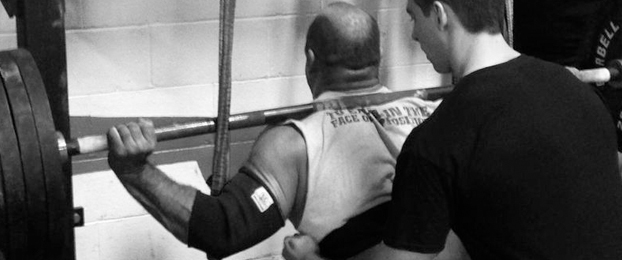
John Bott’s Squat Rehabilitation Program
Developed by
R. Narcessian
Researched by
D. Morrison, I. Wolfe, R.D. Gibson, R. Narcessian, L. Bigliani, G.V.B. Cochran
From Columbia Presbyterian Hospital, New York, New York and Helen Hayes Hospital, West Haverstraw, New York
On June 17, 2000 while competing in the IPA York Barbell Strength Spectacular I completely ruptured my right patella tendon while setting up with my opening squat attempt of 780 pounds. On June 23, Dr. Neil Roth performed surgery at Columbia Presbyterian Hospital. I was put in a full length cast for three weeks and then place in a smaller cylindrical cast for another three weeks. After the cast was removed the knee was placed in a brace and I was sent for physical therapy. The initial physical therapy sessions lasted three weeks and consisted of passive and active stretching methods to regain range of motions. I also performed passive and active strengthening methods to regain lost size and strength in the area. Approximately nine weeks after the operation, I began the squat rehabilitation program that I will outline below. It should be noted that I maintained my low back and abdominal strength by training them as hard as possible. I never missed a scheduled bench press workout and think that this helped me “keep the fire” and also get me through the depression that sets in when you have an injury of this nature.
The Squat Program
1. Each squat takes 6 seconds total (3 seconds down (eccentric) and 3 seconds up (concentric).
2. The movement is continuous. There is no pause at the top or the bottom of the movement.
3. The squats can be done with or without a box. I performed them on a box.
4. The top of the thigh should be parallel to the floor unless this range of motion is painful. If it is painful, squat to a depth of 1 inch above the point of pain and return to the starting position. As my range of motion increased through this program my box height went from 17.5 inches to 14.75 inches.
5. A shoulder width stance is recommended for all squats, though I used three different stances (close, medium and wide).
6. Recovery time between the sets should be about a minute.
7. The squats should be performed every other day. Initially, do not perform any other leg strengthening but the squat program. This will let your body tell you if the squatting is causing any problems.
8. In the beginning, perform the squats in front of the mirror. This will ensure that you are not leaning to one side and overloading the non-injured knee.
9. Ice your knees after every workout.
10. Be patient! This rehabilitation process takes time and is often monotonous. Stick with the plan and it will get you back to where you want to be.
Sample Program
Workout #1: 45lbs, 13 reps x 3 sets
Workout #2: 45 13x5
Workout #3: 45 13x8
Workout #4: 45 13x10
Workout #5: 45 13x13
Workout #6: 50 12x5
Workout #7: 50 12x8
Workout #8: 50 12x10
Workout #9: 50 12x12
Workout #10:80 11x5
Workout #11:80 11x8
Workout #12:80 11x11
Workout #13:100 10x5
Workout #14:100 10x10
Workout #15:115 9x9
Workout #16:135 8x8
Workout #17:145 7x7
Notes: When you finish this cycle, repeat but double the weight and keep the reps the same. Each cycle will last about 5 ½ weeks. I was able to resume my normal box squat training after two cycles. The bar weight and band tension was slowly increased. The sample program is designed for a person weighing 280 pounds. The weights that were chosen were based on this bodyweight. After the first cycle, I incorporated some light sled dragging, both forwards and backwards. This was done to help increase leg strength and endurance.
Results:
Meet #1 – York Barbell Strength Spectacular, June 16, 2001 (1 year from day of injury)
Squat – 660, 720, 760
760 was about 88% of my personal record (860)
Meet #2 – IPA Nationals, November 18, 2001 (17 months from injury)
Squat – 700, 760, 800
800 was 93% of personal record.
Meet #3 – IPA Nazareth Barbell Meet, June 23 2002 (2 years from injury)
Squat – 770, 830, 870 PR
If you have any questions about the squat rehabilitation program or would like a copy of the research article, feel free to email me at JTB2040@aol.com
Stay Strong,
John Bott








